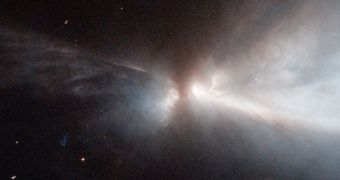The amazing image above was recently captured by astronomers operating the NASA/ESA Hubble Space Telescope. It shows portions of the Chameleon cloud, where a young, blue star is currently forming. This process created a structure called HH 909A, which is represented here by the ethereal object occupying most of the image.
The extreme brightness surrounding the forming star is produced by extremely fast gas outflows from the forming stars. These heated flows then collide with the colder gas around HH 909A to produce large variations in brightness. The designation HH stands for Herbig-Haro objects, which are small patches of nebulosity associated with newly born stars.
Until the star concealed by gas and dust in this image starts supporting nuclear fusion all on its own, the protostar will continue to gulp up material from its surroundings. It will be only after its mass reaches a critical point that the massive cloud of molecular gas will implode on itself, and ignite to form a new celestial fireball.
HH 909A is located very close to Earth, at a distance of just 500 light-years in the constellation of Chameleon. Like other stellar nurseries, including the Orion Nebula, the Chamelon I molecular cloud exhibits a large number of Herbig-Haro objects.

 14 DAY TRIAL //
14 DAY TRIAL //